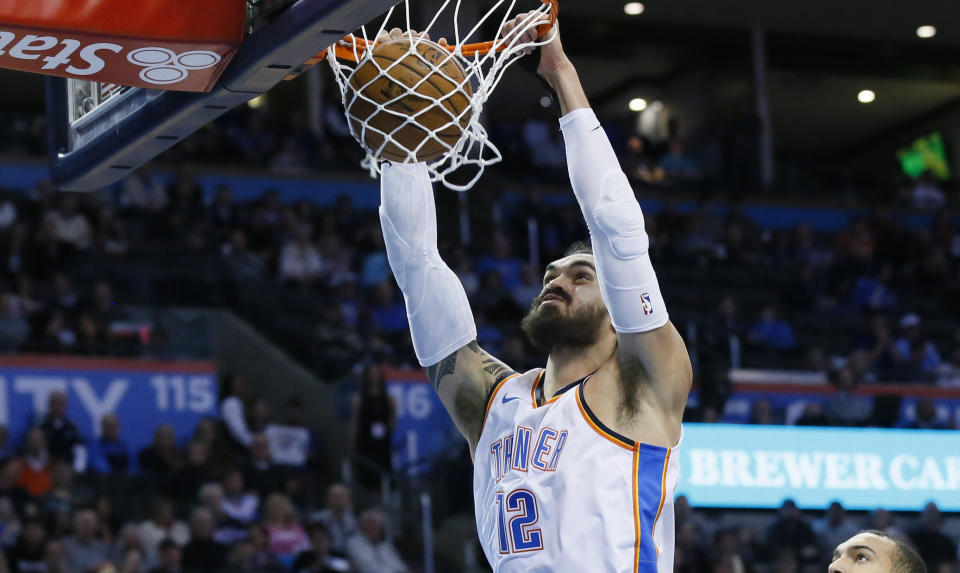Steven Adams is a monster, and the Thunder are finally letting him feast

After five losses in six games, capped by embarrassing back-to-back defeats at the hands of the Dallas Mavericks and Orlando Magic, leading to questions about whether a starting lineup can work with three ball-dominant stars, the dejected Oklahoma City Thunder found a rhythm over their past three games, stringing together wins against the Minnesota Timberwolves, San Antonio Spurs and Utah Jazz.
And the biggest reason for that turnaround has not been Russell Westbrook, Paul George or Carmelo Anthony. It’s been Steven Adams, whose 22 points per game on 28-of-34 shooting (82.4) percent shooting in that stretch has helped what was a bottom-10 offense at November’s end operate at an elite level when he’s been on the floor against three potential Western Conference playoff opponents.
[Follow Ball Don’t Lie on social media: Twitter | Instagram | Facebook | Tumblr]
But before we start wondering how a 7-foot New Zealander who rarely shoots outside the paint could do more to improve their offensive flow than Westbrook, George or Anthony, Thunder coach Billy Donovan is quick to remind us that it is because of those three that Adams is enjoying this success.
“I think people have it really backwards,” Donovan told reporters after Tuesday’s win over the Jazz, via ESPN’s Royce Young. “That’s the greatness, to me, of Carmelo Anthony. The reason why Steven Adams is doing what he’s doing is because of Carmelo Anthony and Paul George.”
[…]
“I think a lot of people don’t see, they look at Carmelo and think, ‘Oh, he’s only taken seven or eight shots in two games,’ and they miss the big picture of what the guy has done for Steven Adams,” Donovan said. “It should be one point for Steven and one point for Carmelo. One point for Steve, one point for Paul. It’s a team. I think you all benefit from each other when you’re out there on the floor and playing the right way.”
This is, at least in part, true. The space created by three All-Stars presents easier opportunities, which in turn has led to career-highs for Adams in scoring (13.5 points per game) and efficiency (67 percent true shooting). This seems like an obvious benefit that everyone on the Thunder should have realized from the jump, but maybe it’s taken the three stars a few weeks to understand their effect on Adams.
However they came to this realization, it’s been a revelation. Without George and Anthony on the roster last season, Adams was still getting about two-thirds of his shots with the nearest defender at least two feet away from him and converting them at a 60 percent clip, according to NBA.com/stats, which is a testament to Westbrook’s greatness. With PG13 and Melo, though, he’s now getting roughly three-quarters of his shots away from tight coverage and shooting 70 percent on those attempts.
The NBA’s closest defender stats are a little erratic for big men anyway, since someone can be within a few feet of you in the paint and still not be contesting your shot, so the reality is that Adams is actually getting far more easier chances with those three around him than even advanced statistics suggest. This is the beauty of being an elite roll man in a lineup with three talented ball-handlers.
Here’s Anthony and Adams running the pick-and-roll against the Spurs almost too easily:
That was only Anthony’s second assist to Adams all season. Both have come in the last three games. Anthony’s biggest contribution to Adams’ success has been his work as a decoy, pulling defenders to the deep corners and wings, but George has had even more direct influence on the 7-footer’s success.
Outside of Westbrook, who assisted on 75.6 percent of Adams’ field goals last season, the only other Thunder player creating shots for their $100 million center was Victor Oladipo, who assisted on just 28 of Adams’ 250 makes (or 11.2 percent). This season, George has almost already eclipsed that mark, assisting on 23 of Adams’ 86 field goals (26.7 percent). That number has been even higher over the last three games, when George has 11 assists on Adams’ 28 field goals — even more than Westbrook (9).
This is the natural evolution of a team incorporating two new stars on a team with one superstar already in place in a single training camp. Initially, they try to figure out how to play with each other, and eventually they find out they need to play with everyone. The 2007-08 Boston Celtics discovered this quicker than most, and Kendrick Perkins was a benefactor. Adams is much better than Perk. Andre Roberson would be reaping the benefits, too, if he wasn’t shooting 20 percent on wide-open 3’s.
The benefit is two-fold, since now opposing defenses must also worry about Adams rolling to the basket. This presents a potentially devastating decision between allowing Adams to work against largely inferior centers or helping on Adams and leaving Westbrook, George or Anthony to feast.
It is no surprise that Adams is attempting two more field goals, shooting almost 10 percent better and scoring 50 percent more points in wins than he is in losses. When the Thunder are willing to feature one of the game’s best pick-setters in a lineup with three players also capable of scoring at a high percentage as pick-and-roll ball-handlers, they are better. Way better. Over the last three games, Oklahoma City is scoring 116.7 points per 100 possessions in 98 minutes with Adams on the floor. In 46 minutes with him on the bench, that number drops to 70.3 points per 100 possessions. (Good lord.)
That’s because even the threat of an Adams pick-and-roll combined with the spacing that Westbrook, George and Anthony creates all sorts of options for the Thunder. This play is the primest of examples:
Adams approaches Westbrook as if they’re running a simple pick-and-roll, only Russ whips the ball to the opposite wing, where George rewards Adams for beating Joffrey Lauvergne on a cut back to the basket. Adams was working almost entirely by himself in 40 feet of space (save for some roaming from Roberson’s man), because the defenders assigned to Westbrook, George and Anthony couldn’t help.
Donovan is right. This works because of Anthony. Enes Kanter would’ve clogged the lane on that play. But it also works because Adams is damn good. This is why the Thunder are paying him $22.5 million. It only makes sense that the Big Three have finally made him the fourth member of their wolfpack.
– – – – – – –
Ben Rohrbach is a contributor for Ball Don’t Lie on Yahoo Sports. Have a tip? Email him at rohrbach_ben@yahoo.com or follow him on Twitter! Follow @brohrbach



